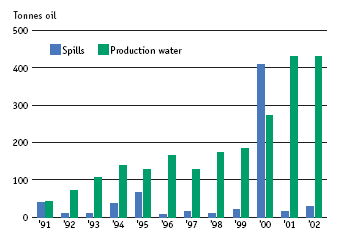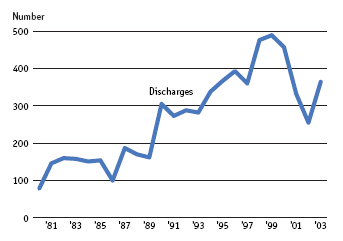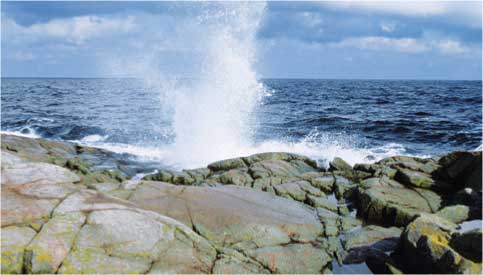|
| Front page | | Contents | | Previous | | Next |
Nature & Environment 2003 – Theme: Water in Denmark
Oil pollution – a threat to the marine environment
Increasing awareness of oil pollution in Danish waters has led to greater efforts by Denmark to prevent oil pollution at sea. A number of new initiatives have been put in
place to ensure that Denmark is ready to respond effectively to oil spills, with the same capabilities as our neighbouring countries.
Oil pollution at sea can threaten our marine environment. Ecologically important areas can be damaged, fish stocks and bird life can be affected, and our beach areas can become
polluted. To combat oil pollution at sea effectively requires preventive initiatives at
both the national and international levels, as well as a response to the actual oil discharges taking place on the open sea and in coastal waters.
International initiatives
International cooperation is the most important weapon in the fight against oil pollution. Denmark has actively participated in international forums to improve initiatives to prevent oil
pollution.
One example of a very significant international environmental achievement is the prohibition of the discharge of oil from ships in the North Sea, which entered into force in August 1999.
The United Nations' International Maritime Organisation (IMO) granted the North Sea status as a "Special Area" with respect to pollution from ships, with oil pollution being an
important element. This prohibition means that ships are only permitted to discharge material containing an oil concentration of no more than 15 mg/l, so that it is not visible.
By 2006, oil discharges from oil rigs must be reduced by 15 per cent in relation to discharges in 2000, and the oil concentration in production water discharges must be reduced from 40
mg/l to 30 mg/l by the end of 2006.
Another international environmental achievement was the introduction in July 1996 of an exclusive economic zone around Denmark. This means that Denmark can enforce international
environmental protection regulations in relation to foreign ships up to 200 nautical miles from the coast. Denmark has also worked to ensure the adoption of regional regulations
compelling ships to surrender oil waste in all harbours in the Baltic region. These regulations entered into force in the middle of 2000.
Monitoring
It is not possible to put a precise figure on the volume of oil illegally discharged in Danish territorial waters each year.
The number of reported observations cannot be directly used as an indicator that there is a serious oil discharge problem in Denmark. In general, over half the observations involve either
light oil/diesel, which evaporates, or false alarms caused by mud/algae/sea currents. However, the reduction in the number of reported observations suggests that some of the initiatives
adopted to combat oil pollution have had a preventive effect. A number of illegal oil discharges continue to occur in the North Sea, despite the ban, leading to pollution of the west coast
of Jutland.

This figure shows the volume of oil discharged from rigs in the North Sea between 1991 and 2002, divided into spills and production water.
Source: The Danish EPA
The indicator shows accidental oil spills and oil discharges in production water from Danish oil rigs in the North Sea for each year between 1991 and 2002. Production water contains
traces of oil and chemicals.
Denmark extracts oil and natural gas from approx. 40 rigs in the North Sea. Discharges of oil with production water have been increasing in recent years. This is due to the fact that the
volume of production water, and hence the oil discharges, increases with the age of the oil fields. Under the OSPAR Marine Convention, covering the north eastern Atlantic Ocean,
including the North Sea, the Skagerrak and the Kattegat, Denmark and the other oil-producing countries in the North Sea are committed to reducing oil discharges in production water
by 15 per cent compared to 2000, by 2006. Apart from one large accident in 2000, spillage from Danish oil rigs in the North Sea is relatively constant. Spillage is primarily caused by
minor incidents involving discharges of less than a tonne. Oil spillage is unintentional, and extensive effort is continually being made to reduce the risk of accidents. The accident in 2000
was caused by problems with the loading buoy in the South Arne Field.

The number of observed oil discharges in the North Sea rose during the 1990s. This increase was due to increased monitoring efforts. Between 1999 and 2002, the
number of observed oil discharges fell
Source: Admiral Danish Fleet
This indicator shows how the number of observed oil discharges in Danish territorial waters has changed since 1980. The number of observed oil discharges has fallen in recent years,
with the exception of 2002, when it rose.
This trend is due in part to increased monitoring efforts, but also to the fact that the ban on discharging oil from ships has been extended to include the Skagerrak and the North Sea, so
that all Danish marine areas are now covered. The increase for 2002 is due to an increase in the number of observations from foreign authorities, as part of the continuing expansion of
cooperative marine environment monitoring initiatives with Sweden and Germany.
The goal is to see further reductions in oil spills and discharges from ships in Danish territorial waters. Denmark is working at international level to secure common requirements for ships
transporting oil.

Particularly sensitive sea areas (PSSA)
If one or more countries wish to increase protection of their marine environments, they can apply to have a clearly defined area declared as a PSSA (Particularly Sensitive Sea Area).
Approval of such areas is handled by the United Nations' International Maritime Organisation (IMO). The IMO has issued a resolution (A927(22)) containing a number of guidelines for
the designation of PSSAs.
According to the guidelines, an area must fulfil one or more of the following criteria in order to be designated a PSSA:
- Ecological criteria (such as unique or rare ecosystem, diversity of the ecosystem, or particular vulnerability to degradation by natural events or human activities).
- Social, cultural and economic criteria (such as significance of the area for recreation or tourism).
- Scientific and educational criteria (such as biological research or historical value).
A PSSA designation makes it possible for a country to enact laws and regulations for the prevention, limitation and monitoring of pollution from ships. Such extra laws and regulations
can, for example, govern the disposal of oil or other harmful substances, requirements that ships carry special equipment (e.g. on oil tankers), navigation guidelines (specification of
navigation routes), or the installation of electronic traffic monitoring systems. Such areas are marked on nautical charts, so that ships entering them are made aware that they are
navigating in a special area.
Source: The Danish EPA

The Baltic Sea
In connection with the extensive oil pollution that occurred off the Danish island of Moen in 2001, agreement was reached that the Baltic countries should investigate what further
measures could be introduced in the Baltic Sea to prevent similar accidents. One of the initiatives was to submit an application to the IMO, for the Baltic Sea (or parts thereof) to be
declared a PSSA. Russia was opposed to such an application, but the other Baltic countries submitted a proposal to the IMO. The IMO Environment Protection Committee approved
the application in principle in April 2004. The PSSA area in the Baltic Sea covers the Kattegat, Øresund (the Sound), and the Belts, and up to the Gulf of Bothnia in the north, but not
the Russian areas off St. Petersburg and Klaipeda.
Approval in principle by the Environment Protection Committee means that the IMO has recognised the areas as being particularly sensitive to impacts from maritime traffic and other
activities in the area, and that there is a need for greater protection than in other areas. Denmark, in cooperation with the other Baltic countries (excluding Russia), will therefore present
specific proposals for improvements to navigational security in the Baltic Sea as soon as possible, with the aim of having the area finally approved by the IMO in summer 2005.
The measures that may be introduced in the Baltic Sea include: increased reporting obligations, greater monitoring of ships, improvements to existing route systems, pilotage in high risk
areas, escorts for certain types of ships, and the designation of areas where ships are not permitted to sail.
The Wadden Sea
In 2002, Denmark, the Netherlands, and Germany succeeded in having the Wadden Sea approved as a PSSA. The countries agreed at that time, that there was no need for further
initiatives, but the need to promote maritime security will be further discussed regularly, up until the next trilateral government conference in 2005.
Source: The Danish EPA
| Front page | | Contents | | Previous | | Next | | Top |
Version 1.0 October 2004, © Danish Environmental Protection Agency
|